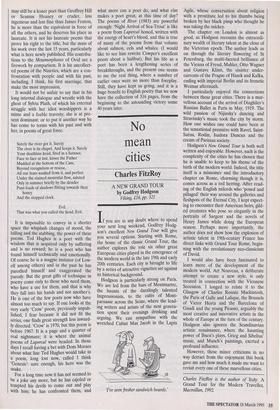No mean cities
Charles FitzRoy
A NEW GRAND TOUR by Godfrey Hodgson Viking, £16, pp. 321 If you are in any doubt where to spend your next long weekend, Godfrey Hodg- son's excellent New Grand Tour will give you several options. Starting with Rome, the home of the classic Grand Tour, the author explores the role six other great European cities played in the emergence of the modern world in the late 19th and early 20th centuries. Each city is brought to life by a series of attractive vignettes set against its historical background. Hodgson is particularly strong on Paris. We are led from the bars of Montmartre, the haunts of the dazzlingly talented Impressionists, to the cafés of Mont- parnasse across the Seine, where the lead- ing writers and artists of the next genera- tion spent their evenings drinking and arguing. We can sympathise with the wretched Cubist Max Jacob in the Lapin `I've seen fresher sandwich boards.' Agile, whose conversation about religion with a prostitute led to his thumbs being broken by her black pimp who thought he was taking the mickey.
The chapter on London is almost as good, as Hodgson recounts the extraordi- nary wealth of literary talent at the close of the Victorian epoch. The author leads us on through the literary flowering of St Petersburg, the multi-faceted brilliance of the Vienna of Freud, Mahler, Otto Wagner and Gustave Klimt, the sinister under- currents of the Prague of Hasek and Kafka, ending with imperial Berlin and its frenetic Weimar aftermath.
I particularly enjoyed the connections between these great cities. There is a mar- vellous account of the arrival of Diaghilev's Russian Ballet in Paris in May, 1919. The wild passion of Nijinsky's dancing and Stravinsky's music took the city by storm. How one wishes one could have been at the sensational premiere with Ravel, Saint- Saens, Rodin, Isadora Duncan and the cream of Parisian society.
Hodgson's New Grand Tour is both well written and enjoyable. However, such is the complexity of the cities he has chosen that he is unable to keep to his theme of the birth of the modem world. Indeed, the title itself is a misnomer and the introductory chapter on Rome, charming though it is, comes across as a red herring. After read- ing of the English milords who `poxed and pillaged' their way around the galleries and fleshpots of the Eternal City, I kept expect- ing to encounter their American heirs, gild- ed creatures who pose so elegantly in the portraits of Sargent and the novels of Henry James while doing the European season. Perhaps more importantly, the author does not show how the explosion of artistic talent in 19th-century France has direct links with Grand Tour Rome, begin- ning with the revolutionary neo-classicism of David.
I would also have been fascinated to learn more of the development of the modern world. Art Nouveau, a deliberate attempt to create a new style, is only treated in connection with the Viennese Secession. I longed to relate it to the Glasgow of Charles Rennie Mackintosh, the Paris of Galle and Lalique, the Brussels of Victor Horta and the Barcelona of Gaudi and the young Picasso, arguably the most creative and innovative artists in the whole of Europe at the turn of the century. Hodgson also ignores the Scandinavian artistic renaissance, where the haunting power of Ibsen's plays, Grieg and Sibelius' music, and Munch's paintings, exerted a profound influence.
However, these minor criticisms in no way detract from the enjoyment this book gave me and how much it made me want to revisit every one of these marvellous cities.
Charles FitzRoy is the author of Italy: A Grand Tour for the Modern Traveller, Macmillan, 1992.


























































 Previous page
Previous page